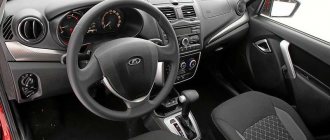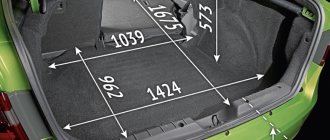Background[edit | edit code]
In the mid-1950s, NAMI developed a promising type of minicars and their units, planned for development during the implementation of the Seven-Year Plan for the Development of the National Economy (1959-1965). This type included three types of cars: a four-seater general-purpose microcar intended for sale for individual use (the future ZAZ-965); a two-seater microcar for disabled people, designed to replace wheelchairs from the Serpukhov plant (the experienced NAMI-031, did not go into production) and a light multi-purpose cargo-passenger vehicle, designed to transport four people, or two people and 200–250 kg of cargo.
The development of the latter concept was started by NAMI in 1958 together with the Irbit Motorcycle Plant with the construction of a prototype NAMI-049 “Ogonyok”, the design of which was largely based on the previously developed military amphibious all-terrain vehicle NAMI-032G (late 1956 or early 1957). The car had a steel supporting base and body frame (pillars, windshield frame, tailgate opening), onto which fiberglass outer panels (tails, doors, hood, side) were attached. As a result, an optimal combination of weight was achieved - only 752 kg in running order - and dynamic qualities - the maximum speed with a 22-horsepower Irbit MD-65 engine was 80 km/h, as well as fuel consumption - 6.7–7.1 l/ 100 km, depending on road conditions. Independent torsion bar suspensions on trailing arms, permanent drive to the front axle with the rear axle being disengaged, lockable wheel differentials, and wheel gearboxes were used. The carrying capacity was 300 kg with two passengers, or four passengers.
Subsequently, the designers of a repurposed for the production of minicompact cars (Zaporozhye, Ukrainian SSR) joined the work on the car, on which prototypes of the NAMI-049A “Tselina” (light truck) and ZAZ-969 were created, unified in the power unit with the ZAZ model that had just been mastered by the plant -965 “Zaporozhets”.
What's the result?
Of course, LuAZ 969 m is not an amphibian, but its origin is felt at first sight. The body compactly houses the motor and gearbox, main gear and cardan in a sealed housing, which is also placed in a pipe for reliability. The suspension travel is impressive even by today's standards, providing ground clearance of 28 and 30 centimeters under the front and rear axles.
The off-road arsenal is complemented by excellent toothy tires, gearboxes, a differential and thoughtful weight distribution: weighing less than a ton, the front-wheel drive LuAZ has a body shifted to the front axle and an engine also located in the front. As a result, this little guy climbs mountains and makes his way through difficult terrain like a small tank: slow, persistent, but stable and purposeful.
There is an opinion among the people that the engines from the Cossacks did LuAZ a disservice, greatly reducing its potential. However, it should be noted that it was thanks to these engines that the Zhuzhik was not only born, but also entered the masses. In addition, unlike the rear-engine "Gorbaty", LuAZ was not prone to overheating.
But he drove about the same. Reviews from owners say clearly: dynamics are not about the 969. It’s definitely not worth driving long distances without skill; experienced drivers say that in the first two gears the car drives like a tank. Only in fifth gear does the feeling of driving begin.
You can drive comfortably at 60 km/h, and an interesting detail appears here. By nature, the LuAZ is not equipped with any sound insulation (of course, it is, but in fact it’s useless), however, when you pick up speed, the noise in the cabin becomes less (or you just get used to it). When over time you begin to feel the car, you reach the optimal speed and calmly drive at a constant speed from gas station to gas station.
Modernization
The first Bagpipe models, despite the use of advanced technologies, had many shortcomings. Therefore, the Lutsk Automobile Plant soon raised the question of modernizing the SUV. This is how the first modification of the LuAZ-969M was born.
First of all, the designers sought to increase engine power. But the chassis was not left without attention. The body and interior have been significantly improved. The design of the car also changed a little - for the first time on the Bagpipe, full-fledged windows appeared on the side, and the seats began to be equipped with seat belts. Attention was also paid to the issue of sound insulation. The solution to this problem was the installation of appropriate panels.
The modernized car did not lose its position and was actively sold in the domestic market. And even now there are a lot of advertisements for the sale of this miracle of the Soviet automobile industry.
Power unit
Despite the fact that domestic cars are difficult to classify as the elite category of the automotive industry, minor modifications to the LuAZ will allow you to get a completely decent vehicle both in terms of driving parameters and in terms of comfort. The main changes concern the power plant, chassis and interior equipment.
The standard SUV engine has a good “appetite”. It consumes about 14 liters of fuel per hundred kilometers. Moreover, the engine capacity is only 1.2 liters. Other features of the power plant of the car in question are given below:
Appearance
Despite its small size, the body consists of an integrated spar-type frame. Volyn is equipped with a tent top, which allows it to be universal. Small doors hang on hinges, thereby simplifying installation and dismantling.
The 969th model also differs from other cars in that the windshield wipers are attached to the top, and not, like other cars, to the bottom, which is a positive thing when driving in bad weather.
If in the previous model the arcs were needed only for attaching the awning, then in the “M” version they come already in a strengthened state. They protected the interior when the car rolled over. When updating the LuAZ-969M, it received new lighting equipment. Locks were installed on the doors, and seat belts appeared.
One of the most serious drawbacks of the bagpipe body was its susceptibility to corrosion. But this disadvantage can be easily solved with a simple brush. The awning does not have any particularly negative aspects, however, those who like to travel along forest roads should install a hard metal roof.
Then it will no longer be scary that branches can tear the roof. With the arrival of the update, the appearance of the vehicle was changed. For the first time, Bagpipe began to have full-fledged windows.
In addition, special attention was paid to sound insulation. They installed a windshield with a different shape, and the doors already had locks (that’s what you thought, they had never installed locks before!).
The front body became less angular, and the car began to look different. It's not so easy to believe, but a small car, from a small city in the big Soviet Union, was able to achieve international recognition.
And these are not just words, for example, even before serial production, in 1978, at the International Motor Show in Turin, the 969th model entered the top 10 best off-road cars in Europe!
It is clear that the automotive market for off-road models was previously a little different, but this does not change the essence of the matter.
Bottom line
LuAZ 969 is a legendary car that stands on a par with UAZ and Niva, and in some respects even surpasses them. If you decide to buy a Volyn, keep in mind that you will have to devote a lot of time to bringing and maintaining the car in good condition. There are a great many options for tuning it, but experts do not recommend installing a more powerful engine, because the machine components are simply not designed for the increasing loads in this case.
Source https://www.neftyanic.ru/transmission-device-louaz-969m/ Source https://procrossover.ru/krossovery-i-vnedorozhniki/istoriya/luaz-969.html
Ignition system features
Since the civilian version of the car could not swim, the ignition systems were designed according to the classical scheme:
- Battery-coil design with one spark plug per cylinder;
- The battery is standard 6ST-55;
- Alternating current generator G-501 (or G-502 on modifications);
- Rectifier unit BVG-2A;
- Blocking relay;
- Fuses (6 pcs).
LuAZ 969 instrument panel with fuses.
Also on the instrument panel there are 2 thermometallic fuses with a nominal value of 20A for protection:
- Heater electrical circuit;
- Lighting of the body and engine compartment;
- Plug sockets;
- Sound signal;
- Brake alarm systems (see also wiring diagram Niva 21213).
https://youtube.com/watch?v=tkANFBOcU8w
A bimetallic fuse is also used to protect the windshield washer and wiper circuit. It is installed under the hood and has a response threshold of 3.5A.
LuAZ-969M "Volyn" photos
photo of LuAZ-969 “Volyn”
photo of LuAZ-969 “Volyn”
photo of LuAZ-969M “Volyn”
photo engine LuAZ-969M “Volyn”
photo of LuAZ-969M “Volyn”
photo of LuAZ-969M “Volyn” on tracks
Design[edit | edit code]
The body of the LuAZ-969 car is semi-supporting, with an integrated spar-type frame. The layout of the car is characterized by a strong displacement of the passenger compartment forward, which made it possible to achieve a constant high load on the front axle, thereby ensuring high traction and grip properties even when driving only the front wheels.
The engine is a V-shaped, four-cylinder, very close to the engines of small cars of the Zaporozhets brand. Until 1975, LuAZ was equipped with a MeMZ-969 engine with a displacement of 877 cm³ and a power of 30 hp. With. (analogous to Zaporozhets engines models 965A and 966B), after - MeMZ-969A, 1197 cm³ and 40 hp. With. (analogue 968). Regardless of the version, the engines were equipped with a cooling system with a forcing (and not an exhaust, as in early Zaporozhets models) fan, which took air through a grille in the front end lining and drove it through the cooling jackets of the engine heads and cylinder block, while the direction of the flow The air was set by a system of sheet metal casings installed on the engine (much less developed, however, than on later Zaporozhets models). In addition, the lubricating oil circulating in the engine was cooled in the oil cooler and in the engine crankcase, the pan of which had a ribbed surface that facilitated heat dissipation. Unlike the Zaporozhets, there were no thermostats in the engine cooling system; the engine temperature during warm-up and in winter conditions was maintained manually by the driver due to the blinds installed between the front end lining and the fan, driven by a handle on the instrument panel (which was much more reliable than automatic adjustment of air flows on "Zaporozhets"). Made as a separate unit, the interior heater could be used in winter to preheat the engine.
Transmission diagram for LuAZ vehicles (all-wheel drive version).
The LuAZ transmission as a whole is characterized by a comparative simplicity of the device by the standards of SUVs (double-shaft gearbox, absence of cardan shafts and transfer case), which has a positive effect on the weight-dimensional characteristics and reliability. The main gear and twin-shaft gearbox are located in the front of the car and are combined into a single unit (transexl), partly similar to that used on Zaporozhets cars (the crankcase, except for the rear cover, and many other parts are unified with the gearbox of 1.2-liter 40-horsepower models "Zaporozhtsev"). Gear shifting is carried out by a floor lever located on the rear cover of the gearbox housing, and the shift layout differs from the traditional one (“mirror”): the first gear is engaged by moving the lever from neutral towards you and back, the second - towards you and forward, the third - from neutral back , fourth - from neutral forward, reverse - from neutral away from you and forward. A power take-off mechanism from the secondary shaft, used either to drive various agricultural equipment, or (on all-wheel drive versions) to drive the rear axle, and (also on all-wheel drive versions) a reduction gear is also mounted inside the gearbox housing cover.
From the very beginning, the gearbox of LuAZ cars had a fully synchronized series of forward gears and a hydraulic clutch (its external feature is a technological connector in the middle of the main gear housing) - unlike the Zaporozhets, whose versions with engines with a working volume of 750 and 877 cm³ were equipped with a different architecture (“Fiat”) gearbox with unsynchronized first gear and cable-operated clutch (with a technological connector between the clutch bell and the gearbox housing itself). The LuAZ variants with the 877 cc MeMZ-969 engine differed from the later 1.2-liter ones only in a different clutch bell (made together with the front half of the final drive housing). The gearbox for the Zaporozhets with a 1.2-liter engine was designed on the basis of the LuAZ transmission by eliminating the power take-off mechanism with reduction gear from its design, installing a pair of fourth gear gears with a higher gear ratio and developing a new gear shift mechanism designed for remote traction drive.
For all-wheel drive modifications, rotation is transmitted from the power take-off shaft of the gearbox to the rear axle gearbox using a thin shaft without hinges, enclosed inside the transmission pipe connecting the gearbox and rear axle housings. Thus, all the vehicle’s transmission units, except for the axle shafts, are essentially enclosed in a common sealed crankcase, which is a legacy of LuAZ’s amphibious past. The rear axle is disabled in the normal state of the transmission; it can be connected from the driver’s seat, for which it is necessary to move the lever located to the left of the gearshift lever to the rear position (with the lever in the forward position, the rear axle is correspondingly disabled). There is no center differential, so when driving on paved roads, the rear axle must be disengaged, and the car becomes front-wheel drive. The same lever also controls the inclusion of a downshift - to engage it in the connected rear axle mode, you must move the rear axle connecting lever away from you and move it forward, while the gearbox lever must be in the neutral position.
To prevent one of the rear wheels from slipping, the rear axle differential can be forcibly locked from the driver's seat by a curved lever located next to the parking brake lever. The locking mechanism is with a gear coupling. There is no front axle differential lock.
The suspension is torsion bar, on trailing arms, with large strokes. The wheels are 13-inch, with a developed mud tread pattern. The wheel pattern corresponds to that used on rear-wheel drive Moskvich cars, but the wheels themselves are original, with a large positive offset, and, unlike other AvtoZAZ products, they have a disk design.
Brakes are drum brakes on all wheels, hydraulically driven, without power assistance.
General description of the family
- (1967-69);
- (1969-75);
- (1975-1979);
- (1979-1992);
Also closely related to it are automobiles:
The transmission output signal is transmitted through the driveshaft to one or more differentials, while a differential may also provide gear transmission, its main purpose is to allow the wheels at either end of the axle to rotate at different speeds as it changes direction of rotation. Early gears included right angle drives and other gearing in windmills, horsepower and steam engines, in support of pumping, milling, most modern gearboxes are used to increase torque while reducing the speed of the prime mover output shaft.
- LuAZ-1302
; - LuAZ-2403
; - LuAZ-1301
;
LuAZ-969 was the first-born of the domestic automotive industry in a number of ways. It was the first domestic front-wheel drive car (version “969B” without rear axle drive); the first SUV that was a consumer item, that is, officially sold “for personal use”; the first production domestic car created specifically for the needs of village residents.
This means that the transmission shaft rotates at a lower speed than the input shaft. The gearbox can be set to the opposite and provides increased speed as torque decreases. Some of the simplest gearboxes simply change the direction of rotation of the power transmission.
Many typical automotive transmissions include the ability to select one of several ratios, in which case the majority of the ratios are used to slow the engine's output speed and increase torque. Volyn region - Volyn region is a region in the north-west of Ukraine. Kovel is the westernmost city, and the last station in Ukraine is the line from Kyiv to Warsaw. During the interwar period, much of the territory, organized as Volyn Voivodeship, was under Polish control, many Ukrainians rejoiced at reunification, but the Polish minority suffered a cruel fate.
The functional design and simplified bodywork, which provided only the most minimal comfort, corresponded to the purpose of the car, and its cross-country ability is outstanding to this day.
The car caused and still causes polar assessments and opinions. Many owners note the very high cross-country ability and practicality of LuAZ vehicles. Others criticize them for their low quality of workmanship, low comfort, very difficult access to the front seats, labor-intensive maintenance and lack of dynamics. Objectively, this car was generally not bad for what it was created for - use in rural areas, mainly on bad roads, where high maximum speed is not important, and good interior trim only makes it more difficult to clean it from the dirt that is inevitable in such conditions. The obvious disadvantage of the car was the Zaporozhets engine - noisy and not powerful enough, which was corrected in later modifications.
Thousands of Poles, especially retired Polish officers and intellectuals, were deported to Siberia, most of these deportees died in the extreme conditions of Soviet labor camps, and most of them were never able to return to Volhynia. The region became the basis of several networks, and many members of the population served the guerrillas. Poles in the area of part of the Polish Army. When they became disillusioned with the Nazi program, they began to target all non-citizens for elimination. Most Poles remaining in the region were forced to leave for the Recovered Territories of western Poland, whose German population had been expelled.
Light SUVs of similar class for the army or village residents were also created abroad - for example, the West German DKW Munga (1956-1968), Haflinger (1959-1974) and Volkswagen Iltis (1978-1988), the East German one, adopted for service The Soviet army as a TPK is a “front line transporter.”
During the Korean War (1949-53), there was a need for a lightweight, floating all-terrain vehicle for transporting ammunition, evacuating the wounded from the battlefield, reconnaissance, towing light guns and mortars, and similar tasks. GAZ-69, for all its positive qualities, was not quite suitable for performing these functions, just like the overly specialized amphibian GAZ-46 (MAV - “small waterfowl vehicle”) created on its basis.
Some of the Ukrainians on the side, especially around the city of Kholm, were also forcibly resettled in Ukraine. The area experienced rapid industrialization, including the construction of the Lutsk Automobile Plant, yet the area remains one of the most rural areas of the former Soviet Union.
Disc Brake - Motion energy is converted into waste heat which must be dissipated. Hydraulic disc brakes are the most commonly used form of brake for cars; compared to drum brakes, disc brakes provide better stopping because the disc cools more easily. As a result, discs are less susceptible to brake fade caused by overheating brake components, and disc brakes also recover faster from sinking. Most drum brake designs have at least one leading shoe that produces a servo effect, and this tends to give the driver better feel and help avoid impending lockup.
Development began in the mid-fifties in NAMI by a group led by B. M. Fitterman. The prototype, designated NAMI-049 (some sources mention the all-terrain vehicle’s own name - “Ogonyok”), was ready by 1958. It had a fiberglass body with a reinforced load-bearing base, independent torsion bar suspension on trailing arms, permanent drive to the front and rear axles connected through a lockable center differential, lockable axle differentials, wheel drives and a 22 hp MD-65 motorcycle engine. The latter turned out to be too weak, had a short resource and did not develop the proper traction properties. In addition, the plastic body turned out to be too fragile.
Drums are also prone to bellhousing penetration and trapping of lining wear material in the assembly, with the brake rotor typically made of cast iron, but in some cases it may be made of composites such as reinforced carbon-carbon or ceramic matrix composites. However, the choice of metals during this period meant that he had to use copper as the braking medium acting on the disc. Instead of a disc with a caliper compressing on it, this system used twin discs that were rubbed onto the surface of a cast iron brake drum.
The second sample was designated NAMI-049A. Specialists from NAMI and the Zaporozhye plant, who in those years were working on the project of the Zaporozhets small car, were involved in its participation. For the military amphibian, one of the engine options designed for the Zaporozhets was considered suitable - a V-shaped, four-cylinder, air-cooled. Further work on the small car and the amphibian was carried out in parallel.
The discs move apart to create friction against the surface of the drum through the action of standard wheel cylinders. Servo. In control engineering, a servo mechanism, sometimes shortened to servo, is an automatic device that uses negative error feedback to correct the action of the mechanism. It typically includes a built-in encoder or other position feedback mechanism to ensure that the output achieves the desired effect, a term properly applied only to systems in which feedback or error correction signals help control mechanical position, speed, or other parameters.
The NAMI-049A engine was basically unified with the serial engine of the Zaporozhets, but it also had significant differences - first of all, on the Zaporozhets the engine was located at the rear and was not cooled by the incoming air flow, which required the introduction of forced air cooling using a fan ( However, the ZAZ engine still often overheated in hot weather, and on the future LuAZ, on which it was installed at the front, even despite greater loads, such a tendency was not observed).
For example, the power window control is not a servo mechanism. In contrast, car cruise control uses closed-loop feedback, which classifies it as a servo mechanism, the general type of servo provides position control. Typically servos are electrical, hydraulic, or pneumatic, and they operate on the principle of negative feedback, where the control input is compared with the actual position of the mechanical system as measured by some kind of output transducer.
Any difference between the actual and desired values is amplified and used to control the system as necessary to reduce or eliminate the error. This procedure is a widely used application of control theory; typical servo motors can produce either rotary or linear output. Speed control through a governor is another type of servomechanism, a steam engine uses mechanical governors, another early application is regulating the speed of water wheels. Many autofocus cameras also use a servo mechanism to move the lens precisely, and the hard drive has a magnetic servo system with micromimeter precision.
In addition, instead of a plastic body, they used an open steel one with an awning, abandoned the center differential, and made the rear axle disengageable. The suspension was strengthened to enable parachute landing. The driver's seat was placed in the middle of the car, the orderly sat with his back to him, and the sides of the body were occupied by stretchers with the wounded. There was no propeller - on water the car moved by rotating the wheels, so compared to “real” amphibians it was less adapted to swimming, but more suited to moving on land.
In industrial machines, servos are used to perform complex movements, a servo motor is a special type of motor that is combined with a rotary encoder or potentiometer to form a servomechanism. This assembly, in turn, can become part of another servomechanism. Potentiometers are subject to drift with temperature changes, while sensors are more stable, servo motors are used for both high and low performance applications. At the high end are precision industrial components that use a rotary encoder, at the low end are low-cost radio-controlled servos used in radio-controlled models that use a free-running motor and a simple potentiometer position sensor with a built-in controller.
In its final form, the car received the designation LuAZ-967 and began to be produced in Lutsk in 1961. Before this, the plant repaired vans, manufactured shower units and TSM-6.5 conveyors for silage.
Modernization[edit | edit code]
LuAZ-969A[edit | edit code]
In 1975, the LuAZ-969A
with an improved MeMZ-969A[1] engine (1.2 l, 40 hp). This was the first Lutsk car to bear the LuAZ brand. It could be distinguished from ZAZ-969V and ZAZ-969 by the presence of a window in the awning. About 30.5 thousand cars of this model were produced.
In 1977, a batch of closed all-metal vans was also produced. In E. Thompson's work on Soviet cars it is designated as LuAZ-969F.
LuAZ-969M[edit | edit code]
| LuAZ-969M "Volyn" | |
| Manufacturer | LuAZ |
| Years of production | 1979—1996 |
| Body type | 3-door phaeton (2 (4) seats) - station wagon |
| Platform | LuAZ-969 |
| Type | carburetor |
| Volume | 1198 cm3 |
| Maximum power | 40 l. s., at 4100−4300 rpm |
| Configuration | V4 |
| Cylinders | 4 |
| Valves | 8 |
| Max. speed | 120 |
| Cylinder diameter | 76 mm |
| Piston stroke | 66 mm |
| Compression ratio | 7,2 |
| Supply system | Carburetor |
| Cylinder operating order | 1-3-4-2 |
LuAZ-969M
(in development since 1973) was introduced in November 1977[2], mass production was launched in 1979, it was distinguished by an increased mileage to 100,000 km before the first major overhaul, updated components (a more powerful 6TST-50EMS battery, new headlights) [1], as well as the shape, design and finish of the body. A noticeable difference in appearance is the modified front part.
- LuAZ-969M
- Back view
- LuAZ-969M
- Driver's workplace
This model was equipped, like its predecessor, with a 1.2-liter 40-horsepower MeMZ-969A engine, but was equipped with a separate brake drive with a hydraulic vacuum booster on the front circuit. The exterior of the car has been modernized: the front panels and the shape of the windshield have changed. The doors were equipped with locks, their side windows received a rigid frame and opening “windows”, a soft instrument panel, a safety steering column and “Zhiguli” seats appeared in the cabin.
Even before the launch of the series, the LuAZ-969M was highly praised at the Exhibition of Economic Achievements of the USSR, and in 1978, at the international salon in Turin (Italy), it (as indicated in a number of sources) entered the top ten best cars in Europe. In 1979, at an international exhibition in the city of Ceske Budejovice (Czechoslovakia), he received a gold medal as one of the best cars for village residents.
LuAZ-2403 was created on the basis of this vehicle.
.
LuAZ-1302[edit | edit code]
Maximum lateral stability angle - 40 degrees; Fording depth - 0.5 m; Wheels:
- wheels - 4.5J/13;
- tires - 175/80R13.
In 1991, small-scale production of LuAZ-1302
. The key difference between this modification is the MeMZ-245-201K generation engine, intended for Tavria and LuAZ-1301[3] (1.1 l, 53 hp, liquid cooling).
External differences from the “969M” consisted of the appearance of a thick spacer between the front panel and the front wings, as well as the transfer of the side lamp from the sidelight to the headlight. The car had reinforced side members, a new instrument panel, additional noise and vibration insulation and more comfortable seats from Tavria (in the production part, old Zhiguli seats were installed). Fuel consumption and noise have decreased significantly, dynamics have improved.
On May 9, 2002, the plant decided to stop production of LuAZ-1302 (instead of which it was planned to master the production of LuAZ-1301M)[4].
Engine tuning
Let's start with the fact that the engine needs to be modified. The reasons have been identified, all that remains is to eliminate them. Let's run a little ahead and say that someone is modifying the standard engine, and someone is changing it to a VAZ one. We will consider each option separately.
Refinement of the standard engine
Tuning the LuAZ 969m engine is primarily aimed at increasing reliability and reducing fuel consumption. Therefore, there is a clear list of measures that apply not only to this motor, but to any other.
- Installing another carburetor. Adapters for the DAAZ 2105 are available for sale. This will not only help increase engine reliability during cold starts, but will also reduce fuel consumption, but slightly. In addition, in the event of a breakdown, spare parts for it will not be difficult to find.
- Installing another air filter. Perhaps the “filter pan”, like that of VAZs, does not cope with its responsibilities. And the engine needs to “breathe deeply.”
- Grinding of cylinder heads. As you know, the MeMZ 968M has a V-engine, so operations will have to be carried out with both heads. To do this, you need to grind off the landing plate by 1-2 millimeters. Due to this, the combustion chambers will be reduced, which means the compression ratio will increase, which, in turn, will lead to a significant reduction in fuel consumption.
You shouldn’t be too zealous, because practice has shown that grinding more than 2.5 mm leads to breakage of the head mounting studs, the explosion becomes so strong. The standard compression ratio is 7.4, while after grinding it increases to 9. This is a critical value, exceeding which will lead to engine damage, possibly even burning out the pistons.
- After grinding, it is necessary to use 92-grade gasoline, which means it is necessary to replace the piston rings with better ones. In addition, the operating temperature will also increase, so you need to think about forced cooling.
- Some craftsmen bore cylinders for a piston of 79 mm, from 2106, therefore, the volume increases to 1.3 liters. The power in this case increases up to 60 horsepower.
- It is advisable to split the exhaust system into 2 exhaust pipes, which will allow for more fine-tuning of engine operation. Since the ventilation of the cylinders will be significantly improved
Modifications[edit | edit code]
Family "969"[edit | edit code]
- ZAZ-969V
/
LuAZ-969V
/
LuMZ-969V
(1966 or 1967—1971 or 1972) - temporary version, front-wheel drive; - ZAZ-969
/
LuAZ-969
(1971-1975) - serial with a 4x4 wheel arrangement; - LuAZ-969A
(1975-1979) - first modernization, MeMZ-969A engine; - LuAZ-969M
(1979-1996) - second modernization, updated body;
Family "1301" (experimental)[edit | edit code]
The project to update the LuAZ SUV model range is not to be confused with the next LuAZ-1301 platform.
- LuAZ-1301
(experimental car of 1984) - is a platform (chassis and engine) of LuAZ-969 (the “969M” modification was taken as the basis) with a new body. Later the engine was replaced with a motor from Tavria.
Family "1302"[edit | edit code]
Options with liquid-cooled engines, mainly MeMZ-245. Production ended May 9, 2002[5]
- LuAZ-13021
(prototype) - a cargo modification of the LuAZ-969M with a base extended by 200 mm and a cargo platform[6]. Subsequently, the type of onboard body was changed, and the base for the production model became 1302; - LuAZ-13021
is a serial flatbed truck with a carrying capacity of 400 kg[7]. Some options were equipped with a gearbox from Moskvich-2141 without drive to the rear axle; - LuAZ-13021-03
- modification of model 13021 with a normal rigid cabin and a sunroof; - LuAZ-13021-04
is a long-wheelbase cargo-passenger modification of model 1302, created for mobile repair teams to maintain power lines and pipelines. There are four seats in the double cab; up to 250 kg of cargo can be transported on a shortened cargo platform[8]; - LuAZ-1302-05 “Foros”
(1998) - a commercial modification of the LuAZ-1302 with a 37-horsepower Italian diesel engine “Lombardini” LDW-1404 and an open body with roll bars[9]. - LuAZ-13021-07
- a variant of model 13021-04 with an extended van-type body with a fiberglass top and a metal tailgate[8] - LuAZ-13021-08
is a modification of model 13021-07 for the Ambulance service. The top is made of fiberglass. To conveniently accommodate stretchers, the rear part of the body has been lengthened by more than 600 mm, resulting in an increased rear overhang. The body has four doors: one on the left, two on the right and a rear one[8]
Reliability and safety
If we talk about the durability and reliability of this vehicle, then there are many conflicting opinions among drivers. A clear advantage is the Zaporozhye power system itself, which is included with the machine.
It is located in front, which avoids difficulties with its overheating. However, it also has its own rather significant drawback - low engine life.
Speaking about the devices themselves that ensure the safety of the driver and passengers of the car, this model simply does not have them. You won’t find seat belts or airbags here, which are simply “stuffed” with cars of the latest generations.
Such decisions can be explained quite easily - in those years when the car was being designed, no one thought much about it. Therefore, when driving such an off-road vehicle, you will be able to get unique sensations that cannot be found on modern jeeps.
Prices and options
Since the vehicle was discontinued from serial production a long time ago, it is only possible to buy it second-hand. To ensure that the choice is not wrong, you need to carefully find a car and review a whole stack of advertisements.
It often happens that the car has been subject to corrosion, and it is very unpleasant when the rust eats away the bottom. Generally speaking, the Bagpipe has always had such a drawback, so after the purchase, car owners often have no choice but to weld the body in a new way.
Although, if you look at its cost from a different perspective, which ranges from $200 to $1,000, the compact Soviet SUV can be forgiven, if not everything, then a lot. It’s interesting that you can find advertisements online where Lutsk cars are for sale from $3,000 to $5,000.
It is clear that based on such a cost, the technical condition of these machines is as if they had recently rolled off the assembly line, or they had been tuned. Although the easiest way is to buy a model for $200 and then “upgrade” it with your own efforts, provided that you have free time.
People's love
“Volyn” became famous among the people. She is both loved and hated, but she is clearly not treated with indifference. You can even judge this by the car’s nicknames: the already mentioned “zhuzhik”, “Bagpipes”, “Luntik/Lunokhod”, “jerboa”, “Cheburashka”, etc.
The first popular “rogue” is a great seller to this day, and the reason is not only its outstanding off-road qualities. The almost complete lack of comfort opens up scope for tuning the LuAZ 969, which attracts craftsmen.
You can buy a LuAZ 969 today in several ways:
- from private hands. The price is individual, depending on mileage and condition. There are cases when they sell completely new cars, with a mileage of a couple of kilometers and in perfect condition, the car has just been in the garage for 20-25 years. Collectors are willing to pay a lot of money, which sellers naturally know.
– buy a LuAZ 969 from conservation. Mothballed LuAZs are cars written off from reserve in military units and sold to private individuals. Please note that this way you can only buy early versions, and the condition of the cars can be either close to ideal or practically ruined. In addition, it is necessary to properly depreserve the car and prepare it for use.
Advantages and disadvantages
Pros of the car
- Good off-road performance;
- Spacious interior;
- Low cost of repaired parts;
- Low cost of the machine;
- Small dimensions of the car;
- You can upgrade it yourself;
- Ease of Management;
- Inexpensive to repair;
- Acceptable ride height;
- Good maintainability;
- Canvas top;
- Not a bad gearbox.
Cons of the car
- Not reliable and not long-lasting LuAZ engine;
- Low sound insulation;
- Hard chairs;
- Low maximum speed;
- Lack of security devices and systems;
- The presence of a canvas top;
- High tendency of body metal to corrosion;
- It is not easy to find the necessary parts for a car;
- Hot in summer, cold in winter;
- Small wheels;
- Weak engine;
- Meager interior;
- Noisiness;
- There is no water cooling of the power unit.
Chassis
Alteration of the LuAZ will also be required in terms of the steering and chassis. In the standard version, the car is equipped with high-profile tires, which contribute to swaying and deterioration of handling on the road. The tire width is also insufficient (only 165 mm). Overcoming large snowdrifts or deep mud on such wheels will be very problematic. The diameter of the discs is 15 inches, which is acceptable on uneven areas, but interferes with active acceleration. The disadvantages also include small wheel arches and short travel of the wishbone suspension.
The steering wheel has significant play and operates through a worm mechanism. Its design leaves much to be desired. There is also a problem with the steering control. Remaking LuAZ in this direction means replacing existing parts with high-quality analogues or making new ball joints yourself in a turning workshop. The fact is that this unit has 8 rods, each of which is equipped with a pair of ball ends. As a result, there is a huge backlash and the need for constant maintenance of the element.











